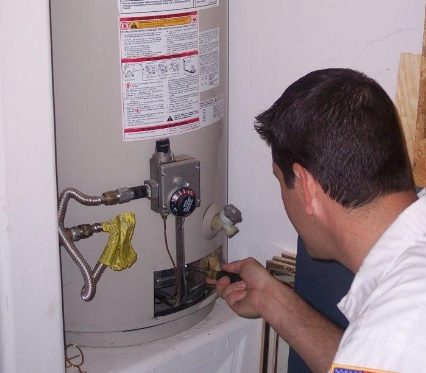If you have a gas water heater in your Glendale home and the gas is turned off for any reason, you will need to relight the pilot light before the unit can start heating again. In gas water heaters, the pilot light works to ignite the gas coming into the unit so it can be burned to heat up the water. If the pilot isn’t lit, the gas can’t ignite and the water heater won’t work. Relighting is usually a fairly simple process, and here is everything you need to know to do it.
Identifying the Type of Pilot Light
The first step is to determine what type of ignition system your water heater has. In the past, all water heaters had what is known as a standing pilot light. This is a small flame that is constantly burning so that the gas can be ignited whenever needed, and this is the only type of pilot light that ever needs to be relit.
Many newer water heaters have what is known as an intermittent or automatic pilot light. Instead of a constant flame, an intermittent pilot only lights when the unit needs to burn gas. Whenever the unit needs to start heating, the pilot automatically turns on and then shuts off again as soon as the heating cycle is complete. As such, intermittent pilots never need to be relit since they don’t stay on constantly.
There are also water heaters that use hot-surface ignition. Instead of a spark or flame, this ignition system uses a small metal probe that is similar to a lightbulb filament. When the water heater needs to run a heating cycle, electricity flows into the probe, which almost instantly makes it red hot. Once the probe is hot, the gas valve opens and the hot probe ignites the gas.

If you’re not sure what type of pilot light or ignition system your water heater uses, check your owner’s manual. You can also tell by looking at your unit when it is running. If you don’t see a constant flame, then your water heater has something other than a standing pilot light so you don’t need to worry about relighting it.
Locating the Pilot Light
The first thing you need to do is locate the pilot light and the gas knob. This is sometimes located within an access panel, but it may be exposed on the outside near the bottom of the unit. Once you’ve found the pilot, look inside and you will see a small tube that leads off from the gas valve. This is the pilot tube that supplies gas to keep the pilot light burning.
You will also see a small metal probe near the pilot tube. This is the thermocouple, which is a safety sensor that detects whether the pilot light is on. If the thermocouple senses that the pilot light isn’t burning, it will automatically shut off the gas flow so that gas can’t leak out and potentially explode.
Most water heaters have an electric igniter button near the gas knob. Pressing this button releases a spark that is used to ignite the pilot light. If your unit does not have an igniter button or if the igniter doesn’t spark, you will need a match or stick lighter to ignite the pilot.
Relighting Your Water Heater’s Standing Pilot Light
The process for relighting a pilot light can vary slightly from one water heater to the next, but the basics should still be the same no matter what. If you are unsure, there should be detailed instructions in your owner’s manual. Most water heaters also have the instructions written somewhere on the unit itself. Most commonly the instructions are on the inside of the access door where the pilot is, but they may also be somewhere else on the tank.
Before attempting to reignite the pilot light, turn the gas knob to off and let the unit sit for five minutes or so. This helps to cool off the thermocouple and make sure that there is no residual gas in the line. Next, turn the knob to the position marked “pilot.” No gas will come out yet so you don’t have to worry.
Once the knob is set to pilot, press the knob down all the way and hold it down. With your other hand, press the ignite button a few times until the pilot lights. If you don’t have an igniter button, put your match or lighter into the pilot hole to manually light it. Once the pilot is lit, continue to hold the gas knob down for 30 seconds or so. The pilot should stay lit once you release the knob, and the knob should raise back up to its original position. If the pilot won’t stay lit, repeat the process again.
After the pilot is lit, turn the gas knob to the “ON” position. You can then turn the thermostat back up to the desired temperature.
Reasons Your Pilot Light Won’t Stay On
If your pilot light won’t stay on, this indicates that there is a problem with the unit. The most common reason that this happens is because of an issue with the thermocouple. If the thermocouple gets dirty, it can prevent it from sensing that the pilot light is burning. As a result, the thermocouple will stop the gas flow and the pilot light will instantly go out. This problem can usually be fixed by taking a small piece of fine sandpaper and gently scrubbing any dirt and debris off of the thermocouple. Take special care not to bend or damage the thermocouple as this will result in it needing to be replaced.
If this doesn’t fix the issue, it could be that the thermocouple is damaged or faulty. The only way to resolve this issue is to have it replaced. This is something you may be able to do on your own, but it is still usually best left to the professionals.
Your pilot light may also not stay lit because of something that is clogging the pilot gas tube. To see if this is the issue, take a small needle and try to clean any debris out of the tube.
If your pilot still won’t stay lit, it is definitely time to call in some professional help. It is most likely that either the thermocouple or the control valve is faulty and will need to be replaced.
At Christian Brothers Air Conditioning, Plumbing & Electrical, we have years of experience working on all types of water heaters and can usually fix most problems. If the issue cannot be fixed, we can also help install a new water heater for your home. We have been providing exceptional plumbing services to customers in Glendale and the Greater Phoenix area for more than 35 years, and our team of HVAC experts can also take care of any air conditioning or heating needs. If you’re having issues getting your pilot light to ignite or stay lit, give us a call today and we’ll be glad to help.










